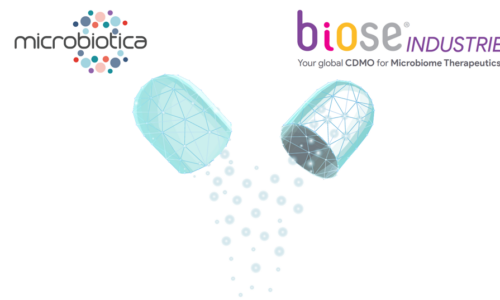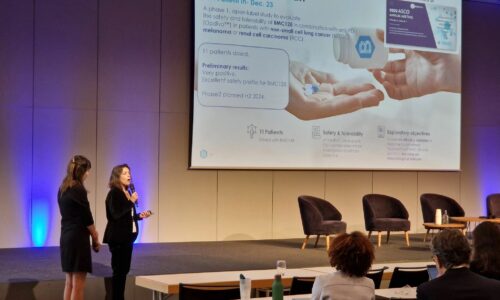Introduction
Kisaco Research’s flagship Microbiome Connect event returned to Boston in November. Joined by a range of microbiome companies and researchers, the event covered both the R&D and manufacturing considerations for microbiome drug development. From freeze-drying techniques for LBP development to synthetic therapeutic approaches, the conference platformed a diverse topic roster.
Some highlights of the event include:
Innovative therapeutic platforms
Focused on a systems approach to targeting the microbiome was Concerto Biosciences. Cheri Ackerman, CEO of Concerto Biosciences, presented on Concerto’s high-throughput interaction platform. Highlighting the work Concerto have done to characterise the skin interactome, Cheri explained how this complex mapping revealed lead candidates for ENS-002. ENS-002 is a defined group of microbes that reduces S. aureus virulence and is poised for in-human trials. The lead candidate “restores protective microbial interactions” to “rehabilitate” the skin microbiome.
Axial Therapeutics opts instead for a small molecule approach to target the gut-brain axis. Stewart Campbell, CEO, explained Axial aims to launch three new clinical programs, focusing on CNS and Oncology indications, in the next 18 months. Campbell explained Axial’s platform is based on Dr. Sarkis Mazmaian’s ground-breaking work into the gut-brain axis. The company showcased data on their phase 2 candidate, AB-2004, which treats irritability associated with autism spectrum disorder. The data highlighted improved irritability and anxiety scores in the cohort.
Leading the development of lung-targeted microbiome drugs, Alveolus’s Vivek Lal presented on their resMIT platform – “Respiratory Microbiota-based Inhaled Therapeutics”. Vivek outlined the rationale for targeting the lung microbiome to develop drugs. He discussed the non-sterile nature of the lower airways and the implication of the pro-inflammatory MMP-9 cascade in Chronic Lung Disease. Alveolus is gearing up to launch into clinic to address neutrophilic inflammation in COPD and BPD indications in 2023.
MaaT Pharma’s, CBO, Savita Bernal detailed their Microbiome Ecosystem Therapy platform. Having generated both native and co-cultured LBP candidates, MaaT’s MET platform marries a cGMP capability with their proprietary gutPrint metagenomics. Savita described the positive relationship between gut microbiome diversity and survivability of cancer patients. Data showcased MaaT013, the company’s phase 3, full ecosystem, candidate improved Graft-vs-Host-Disease patient survival in their HERACLES phase 2 clinical. Described mechanisms for the therapeutic effect of MaaT103 implicate epithelial barrier integrity, microbiome diversity, and inflammation regulation.
For their ApyraMed platform, MVBiotherapeutics leverages the ATP-degrading capabilities of apyrase to increase protective igA production. ApyraMed candidates are recombinant live bacteria which express exogenous antigens and apyrase. Fabio Grassi, CEO, demonstrated anti-biotic treated mice treated with MV-003 were resistant to C. diff colonisation when compared to the control. The ApyraMed platform has applications in immuno-oncology and antibiotic-associated dysbiosis. The company plans on developing this product up to phase 2 to license afterwards.
Manufacturing LBPs
Biose Industries’ Head of Programs, Claire Derlot, Ph.D. gave a presentation on LBP CMC challenges. Derlot outlined Bioses’ leading LBP manufacturing services starting from analytical R&D all the way up to commercialisation. With Biose Industrie’s integrated QC lab, QP Pharmacists for LBP FMP certification and release, summed with its ICH compliant incubators for short to long term stability studies, it showcased Biose as a titan of microbiome manufacturing.
Nicolas Pichon, head of biomanufacturing, Servatus covered single-use vs multi-use manufacturing technologies, as well as describing how Servatus set-up a smart and hybrid production facility. Pichon described single-use vs multi-use reactors as a matter of choice. Merits of single use were: a smaller footprint, infrastructure versatility and quick turnover. Multi-use in contrast was explained to facilitate a larger capacity (up to 20000L) and be resistant to supply chain disruption. Key considerations for deciding between the two modes of manufacturing equipment were: scalability, supply chain management, flexibility, cost, and process complexity. Pichon then explained Servatus’ hybrid approach to manufacturing. Using both single and multi-use equipment, he suggested with this approach, process optimization can be continuous.
Pharmabiome took to the stage to describe their proprietary “COMIT” consortia manufacturing platform – “continuously co-cultivated minimal microbiome therapeutics”. The COMIT platform prioritises microbe interactions to produce a multi-strain drug product. Tomas de Wouters, CEO, described how their process results in high reproducibility, increased yield, high product stability compared to other approaches.
Regulatory considerations
Diving into the need for standards for live microbial products was Kit Goldman, Ph.D., Senior Director for Dietary Supplements and Herbal Medicines, from the US Pharmacoepia. Kit reiterated the FDA’s previously outlined guidance on drug substance and drug product specifications. The quality parameters for live microbial products were described as: relative percentage of strains, enumeration, purity, and stability. Kit described the challenging nature of working with Live microbial products and suggested appropriate methods for meeting regulatory parameters. Goldman contrasted the merits of different enumeration methods including flow cytometry, NextGen sequencing, and qPCR. Another challenge outlined by Kit was defining the ratio of viable:dead cells in a product. Viable but non-cultivatable cells (VBNCs) were explained to be microbes unable to form colonies, but which retain metabolic activity. The “functional” but non-colony forming nature of VBNCs make testing for their presence via plating difficult.
Paul Carlson, Principal Investigator, of the FDA, outlined the regulatory considerations for microbiome-based therapeutics. He detailed the process of filing for an investigational drug application (IND) for microbiome-based therapeutics (FMT and LBPs). Carlson described the challenges in the regulation of FMT, identifying product safety and characterisation as key issues. Regarding FMT, questions such as “What organisms should we test for?” and “what is a good potency assay?” were outlined. The recent FDA safety alerts related to FMT were used to highlight FMT’s intrinsic potential for health risks.
Carlson then described the chemistry, manufacturing and controls (CMC) for LBPs. Drawing from the FDA’s published guidelines, he explained CMC for LBP INDs should include but not be limited to: strain information, antibiotic resistance profiles, cell banking system info, the drug substance/drug product manufacturing process, stability data, manufacturing controls and release testing, and bioburden testing. Carlson described intended use, as being critical in determining a products categorisation as an LBP as compared to a probiotic. The process of filing for an IND utilizing commercially available LBPs was explained; applicants can request a waiver for the requirement for CMC information, which if granted allows for the label on a commercially available LBP to be used in substitute of traditional CMC information.
Conclusion
We enjoyed meeting with new and familiar faces at Microbiome Connect: USA 2022. We look forward to attending more microbiome events and working researchers pushing microbiome therapeutics to commercialisation.


